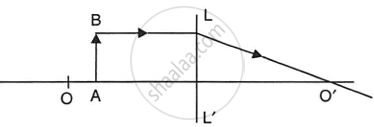Advertisements
Advertisements
Question
A camera fitted with a lens of focal length 50 mm is being used to photograph a flower that is 5 cm in diameter. The flower is placed 20 cm in front of the camera lens.
At what distance from the film should the lens be adjusted to obtain a sharp image of the flower?
Solution
Given:
Focal length, f = 50 mm = 5 cm
Object distance, u =-20 cm
Image distance, v = ?
Putting these values in lens formula, we get:
⇒`1/v-1/u=1/f`
⇒`1/v-1/-20=1/5`
⇒`1/v+1/20=1/5`
⇒`1/v=1/5-1/20`
⇒`1/v=(20-5)/100`
⇒`1/v=15/100`
⇒`v=20/3`
⇒`v=6.66` cm
Film should be adjusted at a distance of 6.66 cm behind the lens.
APPEARS IN
RELATED QUESTIONS
To determine the approximate focal length of the given convex lens by focussing a distant object (say, a sign board), you try to focus the image of the object on a screen. The image you obtain on the screen is always
(a) erect and laterally inverted
(b) erect and diminished
(c) inverted and diminished
(d) virtual, inverted and diminished
What kind of lens can form:
an inverted magnified image?
A convex lens of focal length 10 cm is placed in contact with a concave lens of focal length 20 cm. The focal length of this combination of lenses will be:
(a) +10 cm
(b) +20 cm
(c) −10 cm
(d) −20 cm
Study the diagram given below.

- Name the lens LL’.
- What are the points O and O’ called?
- Complete the diagram to form the image of the object AB.
- State the three characteristics of the image.
- Name a device in which this action of lens is used.
A lens forms an erect, magnified, and virtual image of an object. Name the type of lens.
Where should an object be placed in front of a convex lens so as to form an inverted and enlarged image? Will the image be real or virtual? Draw a ray diagram to illustrate your answer.

Can one bum a piece of paper in daylight by just using a convex lens instead of a match or any direct flame? Support your answer with the help of an appropriate ray diagram.
Distinguish between:
Concave lens and Convex lens
